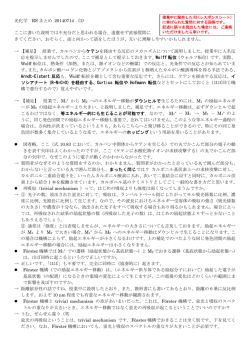
ニュートリノ駆動型 超新星爆発シミュレーション 3Dと2Dの比較
2014/7/8 Joint Meeting among RESCEU-RIKEN-IPMU@RIKEN Explosion Mechanism of Core-collapse Supernovae Tomoya Takiwaki (NAOJ->RIKEN) Press Release in April There are two press release on supernovae in last April One: Lensed extremely luminous type Ia supernova. The other: 3D explosion of type II supernova found in Kcomputer. Why is CC SN interesting? Last time of massive stars Birth of neutron star Mother of supernova remnant One of the most luminous object in the universe Target of Multi-messenger astrophysics Source of heavy elements in galaxies 4 kinds of force affects the explosion mechanism Ni mass~ E_exp Various Kinds of CC supernovae Nomoto+2006 Initial Mass of Progenitor Fate of the star differs from the properties of the progenitor: 1. Mass 2. Metallicity 3. Rotation 4. Magnetic Field Two class of CC SNe We focus on this Neutrino Mechanism Magnetic Mechanism Magnetic Fields Rotation Rotation BH magnetar pulsar Mass Mass Neutrino Mechanism I’ll explain one by one 1. Initial setup 2. Key aspects of neutrino mechanism 3. Simulations 4. Effect of Rotation Neutrino Mechanism I’ll explain one by one 1. Initial setup 2. Key aspects of neutrino mechanism 3. Simulations 4. Effect of Rotation Key aspects of Neutrino Mechanism Radial Velocity Post Shock Postshocked n,p Pressure Shock The shock is stalling. Pressure inside and ram Preshocked pressure out side balances. Fe Ram Pressure RHS is determined by stellar structure(density profile). Radius Entropy~T^3/ρ Fe=>n, p Proto Neutron Star Heated by cooled by neutrino photodissociation LHS is determined by two ingredients. (1) Photodissociation (2) Neutrino Heating A example of the failed supernovae Non-Explosion Is observed Entropy is visualized Spherical symmetric simulations Key aspects of Neutrino Mechanism Entropy~T^3/ρ Heated by convection Fe=>n, p Proto Neutron Star Heated by neutrino cooled by photodissociation Negative entropy gradient leads Rayleigh-Taylor instability (Cold heavy matter is put over Hot light matter) Rayleigh-Taylor convection transfer energy outward. Radius Cooler than the initial state but ν heat is active Hotter than the initial state Neutrino Mechanism I’ll explain one by one 1. Initial setup 2. Key aspects of neutrino mechanism 3. Simulations 4. Effect of Rotation s11.2(Light Progenitor) Ω=0rad/s Explode! Convection Dominant EoS:LS-K220 resolution: 384(r)x128(θ)x256(φ) The finest grid Neutrino Trasport: Ray-by-Ray:IDSA +Leakage Hydro: HLLE, 2nd order Shape of the explosion? Many hot bubble is observed. That is evidence of strong convection. s27(heavey Progenitor) Ω=0rad/s Failed (or need long-term sim.) EoS:LS-K220 resolution: 384(r)x64(θ)x128(φ) Neutrino Transport: Ray-by-Ray:IDSA +Leakage Hydro: HLLE, 2nd order Neutrino Luminosity Mass accretion vs neutrino heating explode GR effect? 11.2 Heavier progenitor results high mass accretion rate and high ram pressure. That spoils the explosion. 27.0 fail Mass accretion rate GR effects(or update of microphysics) can change the situation. Nakamura+14. Nakamura+ 14. slide from suwa Nakamura+ 14. Nakamura+ 14 Neutrino Mechanism I’ll explain one by one 1. Initial setup 2. Key aspects of neutrino mechanism 3. Simulations 4. Effect of Rotation Bar mode instability Rapid Rotation => spiral instability In the rigid ball, Rotational energy(T)/gravtational energy(W)=14% In Sne case, criteria becomes smaller. Called low-T/W instability Neutrino + rotation Spiral wave transfer the energy to the outer regon. Finally explosion is found! Shape of the explosion? Strong expansion is found at equatorial plane The mass of the progenitor and rotation make various type of Explosion(or Non Explosion). Does rotation affect the shock revival? Rapid rotation s11.2 s27.0 Rapid rotation N13 1D=> no shock revival s11.2 : No N13 : Yes s27 : Yes How energetic is that? s11.2 Rapid rotation N13 Rapid rotation Observe 0.1-0.4 10^51erg! It’s close to 10^51 erg! s27.0 Rapid rotation Message Although CC SNe are not completely understood, we are close to solve the problem. (It’s might be semi-final match or final match?) Quite nice model (close to the real one) can be obtained. When should we start the collaboration on astronomy with realistic supernovae model? Now’s the time! 超新星シミュレーションの新問題 多次元モデルは物理のインプットに敏感で手法に よって爆発したりしなかったりする。 爆発する 2次元モデル(複数親星に対して) Bruenn+12:全部爆発 Mueller+13:おおよそ爆発 Dolence+14:一つも爆発しない Nakamura+14:全部爆発 2D 3D Suwa in prep:半分ほど爆発 Hanke in prep:おおよそ爆発 インプットのエラーの範囲 3次元モデル(複数親星に対して) Hanke in prep:一つも爆発しない 1D 爆発しない Takiwaki in prep:半分ほど爆発 超新星シミュレーションの新問題 多次元モデルは爆発する にせよしないにせよ 非常にぎりぎり。 定量的な評価を確定する ためには相当手法に凝る 必要がある! Ott+12 今後は 数値計算の信頼性が とにかく大事! ロードマップ とにかくすべてのインプットをアップデートせよ! Most realistic modelの変遷。 6次元ボルツマン Kuroda in prep Hanke+13 Takiwaki+14 フルGR Non Ray-by-Ray ニュートリノ反応 現象論的GR ペタスケール エクサスケール ~2020 Kuroda論文での結論と6次元ボルツマンでの計算に今後は注目! 2020年ぐらいまでにはかなりの決着を見るのでは? ニュートリノ+磁場 磁気回転不安定性で 対流安定な場所でも 乱流的になる。 それがニュートリノ 加熱に効くかもしれ ない。 高解像度計算が必要 すぐに完全な計算はできない 徐々に調べる 現在、政田くんと研 究中。澤井くんも同 様のことを指摘。 ニュートリノ+SASI爆発 Advective-acoustic cycle Foglizzo’s slides Pressure Wave Vorticity Wave Standing Accretion Shock Instability(SASI) 渦が落ちる時間スケールで成長が律速。 上から物がどんどん降ってくるとき成長しやすい Scheck+ 2008 SASI爆発は起こるか? 2D 3D Takiwaki+2012 Iwakami+14 CC的に爆発しにくいところでドミナントになる 。この不安定性で爆発に転じるのは今のところ難 しい見通し。
© Copyright 2026


